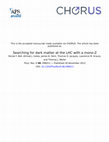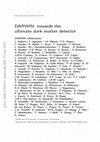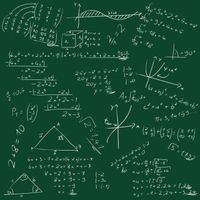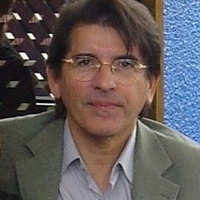Papers by Lawrence Krauss
Physical review, Jul 6, 2018

AIP Conference Proceedings, 2009
Gravitational lensing of the cosmic microwave background by large-scale structure in the late uni... more Gravitational lensing of the cosmic microwave background by large-scale structure in the late universe is both a source of cosmological information and a potential contaminant of primordial gravity waves. Because lensing imprints growth of structure in the late universe on the CMB, measurements of CMB lensing will constrain parameters to which the CMB would not otherwise be sensitive, such as neutrino mass. In CMB polarization, gravitational lensing is the largest guaranteed source of B-mode (or curl-like) polarization. Future CMB polarization experiments with sufficient sensitivity to measure B-modes on small angular scales (ℓ ∼ 1000) can measure lensing with better sensitivity, and on different scales, than could be achieved by measuring CMB temperature alone. If the instrumental noise is sufficiently small (5 µK-arcmin), the gravitational lensing contribution to the large-scale B-mode will be the limiting source of contamination when constraining a stochastic background of gravity waves in the early universe, one of the most exciting prospects for future CMB polarization experiments. High-sensitivity measurements of small-scale B-modes can reduce this contamination through a lens reconstruction technique that separates the lensing and primordial contributions to the B-mode on large scales. A fundamental design decision for a future CMB polarization experiment such as CMBpol is whether to have coarse angular resolution so that only the large-scale B-mode (and the largescale E-mode from reionization) is measured, or high resolution to additionally measure CMB lensing. The purpose of this white paper is to evaluate the science case for CMB lensing in polarization: constraints on cosmological parameters, increased sensitivity to the gravity wave B-mode via lens reconstruction, expected level of contamination from non-CMB foregrounds, and required control of beam systematics.
Journal of Instrumentation
Understanding propagation of scintillation light is critical for maximizing the discovery potenti... more Understanding propagation of scintillation light is critical for maximizing the discovery potential of next-generation liquid xenon detectors that use dual-phase time projection chamber technology. This work describes a detailed optical simulation of the DARWIN detector implemented using Chroma, a GPU-based photon tracking framework. To evaluate the framework and to explore ways of maximizing efficiency and minimizing the time of light collection, we simulate several variations of the conventional detector design. Results of these selected studies are presented. More generally, we conclude that the approach used in this work allows one to investigate alternative designs faster and in more detail than using conventional Geant4 optical simulations, making it an attractive tool to guide the development of the ultimate liquid xenon observatory.
We derive two features of axion cosmology that may have cosmological implications, whether or not... more We derive two features of axion cosmology that may have cosmological implications, whether or not axions are dark matter: For the full range of allowed axion masses, the evolution of a cosmic axion background allows large CP violation until temperatures as low as $\sim$ 2 GeV, and once the axion field begins to oscillate, the cosmological axion field's relaxation to its ground state can briefly provide a new departure from thermal equilibrium, via time-varying CP violation. During both of these periods, the Strong CP violating parameter $\bar\theta$ can be as large as O(1).
Cosmology with MATLAB, 2016
We present a brief review of current theory and observations of the cosmic microwave background (... more We present a brief review of current theory and observations of the cosmic microwave background (CMB). New predictions for cosmological defect theories and an overview of the inflationary theory are discussed. Recent results from various observations of the anisotropies of the microwave background are described and a summary of the proposed experiments is presented. A new analysis technique based on Bayesian statistics that can be used to reconstruct the underlying sky fluctuations is summarised. Current CMB data is used to set some preliminary constraints on the values of fundamental cosmological parameters Ω and H • using the maximum likelihood technique. In addition, secondary anisotropies due to the Sunyaev-Zel'dovich effect are described.

The European Physical Journal C, 2020
We detail the sensitivity of the proposed liquid xenon DARWIN observatory to solar neutrinos via ... more We detail the sensitivity of the proposed liquid xenon DARWIN observatory to solar neutrinos via elastic electron scattering. We find that DARWIN will have the potential to measure the fluxes of five solar neutrino components: pp, $$^7$$ 7 Be, $$^{13}$$ 13 N, $$^{15}$$ 15 O and pep. The precision of the $$^{13}$$ 13 N, $$^{15}$$ 15 O and pep components is hindered by the double-beta decay of $$^{136}$$ 136 Xe and, thus, would benefit from a depleted target. A high-statistics observation of pp neutrinos would allow us to infer the values of the electroweak mixing angle, $$\sin ^2\theta _w$$ sin 2 θ w , and the electron-type neutrino survival probability, $$P_{ee}$$ P ee , in the electron recoil energy region from a few keV up to 200 keV for the first time, with relative precision of 5% and 4%, respectively, with 10 live years of data and a 30 tonne fiducial volume. An observation of pp and $$^7$$ 7 Be neutrinos would constrain the neutrino-inferred solar luminosity down to 0.2%. A co...

The European Physical Journal C, 2020
The DARWIN observatory is a proposed next-generation experiment to search for particle dark matte... more The DARWIN observatory is a proposed next-generation experiment to search for particle dark matter and for the neutrinoless double beta decay of $$^{136}$$ 136 Xe. Out of its 50 t total natural xenon inventory, 40 t will be the active target of a time projection chamber which thus contains about 3.6 t of $$^{136}$$ 136 Xe. Here, we show that its projected half-life sensitivity is $$2.4\times {10}^{27}\,{\hbox {year}}$$ 2.4 × 10 27 year , using a fiducial volume of 5 t of natural xenon and 10 year of operation with a background rate of less than 0.2 events/(t $$\cdot $$ · year) in the energy region of interest. This sensitivity is based on a detailed Monte Carlo simulation study of the background and event topologies in the large, homogeneous target. DARWIN will be comparable in its science reach to dedicated double beta decay experiments using xenon enriched in $$^{136}$$ 136 Xe.
AIP Conference Proceedings, 2009
We summarize existing constraints on the epoch of reionization and discuss the observational prob... more We summarize existing constraints on the epoch of reionization and discuss the observational probes that are sensitive to the process. We focus on the role large scale polarization can play. Polarization probes the integrated optical depth across the entire epoch of reionization. Future missions such as Planck and CMBPol will greatly enhance our knowledge of the reionization history, allowing us

Physical Review D, 2012
We investigate a mono-Z process as a potential dark matter search strategy at the LHC. In this ch... more We investigate a mono-Z process as a potential dark matter search strategy at the LHC. In this channel a single Z boson recoils against missing transverse momentum, attributed to dark matter particles, χ, which escape the detector. This search strategy is related, and complementary to, monojet and monophoton searches. For illustrative purposes we consider the process qq → χχZ in a toy dark matter model, where the Z boson is emitted from either the initial state quarks, or from the internal propagator. Among the signatures of this process will be a pair of muons with high pT that reconstruct to the invariant mass the Z, and large amounts of missing transverse energy. Being a purely elecroweak signal, QCD and other Standard Model backgrounds are relatively easily removed with modest selection cuts. We compare the signal to Standard Model backgrounds and demonstrate that, even for conservative cuts, there exist regions of parameter space where the signal may be clearly visible above background in future LHC data, allowing either new discovery potential or the possibility of supplementing information about the dark sector beyond that available from other observable channels.
Journal of Physics G: Nuclear and Particle Physics
The nature of dark matter and properties of neutrinos are among the most pressing issues in conte... more The nature of dark matter and properties of neutrinos are among the most pressing issues in contemporary particle physics. The dual-phase xenon time-projection chamber is the leading technology to cover the available parameter space for weakly interacting massive particles, while featuring extensive sensitivity to many alternative dark matter candidates. These detectors can also study neutrinos through neutrinoless double-beta decay and through a variety of astrophysical sources. A next-generation xenon-based detector will therefore be a true multi-purpose observatory to significantly advance particle physics, nuclear physics, astrophysics, solar physics, and cosmology. This review article presents the science cases for such a detector.

Physical Review D, 2016
If local supersymmetry is the correct extension of the standard model of particle physics, then f... more If local supersymmetry is the correct extension of the standard model of particle physics, then following Inflation the early universe would have been populated by gravitinos produced from scatterings in the hot plasma during reheating. Their abundance is directly related to the magnitude of the reheating temperature. The gravitino lifetime is fixed as a function of its mass, and for gravitinos with lifetimes longer than the age of the universe at redshift z 2 × 10 6 (or roughly 6 × 10 6 s), decay products can produce spectral distortion of the cosmic microwave background. Currently available COBE/FIRAS limits on spectral distortion can, in certain cases, already be competitive with respect to cosmological constraints from primordial nucleosynthesis for some gravitino decay scenarios. We show how the sensitivity limits on µ and y distortions that can be reached with current technology would improve constraints and possibly rule out a significant portion of the parameter space for gravitino masses and Inflation reheating temperatures.

Journal of Cosmology and Astroparticle Physics, 2016
DARk matter WImp search with liquid xenoN (DARWIN 1) will be an experiment for the direct detecti... more DARk matter WImp search with liquid xenoN (DARWIN 1) will be an experiment for the direct detection of dark matter using a multi-ton liquid xenon time projection chamber at its core. Its primary goal will be to explore the experimentally accessible parameter space for Weakly Interacting Massive Particles (WIMPs) in a wide mass-range, until neutrino interactions with the target become an irreducible background. The prompt scintillation light and the charge signals induced by particle interactions in the xenon will be observed by VUV sensitive, ultra-low background photosensors. Besides its excellent sensitivity to WIMPs above a mass of 5 GeV/c 2 , such a detector with its large mass, low-energy threshold and ultra-low background level will also be sensitive to other rare interactions. It will search for solar axions, galactic axion-like particles and the neutrinoless double-beta decay of 136 Xe, as well as measure the low-energy solar neutrino flux with <1% precision, observe coherent neutrino-nucleus interactions, and detect galactic supernovae. We present the concept of the DARWIN detector and discuss its physics reach, the main sources of backgrounds and the ongoing detector design and R&D efforts.
Physics Letters B, 1983
Abstract The anomalous magnetic moment of the muon ( g − 2) μ imposes constraints on the masses a... more Abstract The anomalous magnetic moment of the muon ( g − 2) μ imposes constraints on the masses and mixings of spin-zero leptons, gauge fermions, and Higgs fermions in minimal models of low energy supergravity. We demonstrate that there exist only limited values of the parameters in these models that are ruled out by existing limits on ( g − 2) μ .
Physics Letters B, 1985
We consider general constraints on baryosynthesis in low-energy SU(3) X SU(2) × U(1) theories. We... more We consider general constraints on baryosynthesis in low-energy SU(3) X SU(2) × U(1) theories. We find in general that phenomenologicaUy acceptable models exist, which are unifiable at higher energies-but which all require exotic fermion content.

Physical Review D, 1986
%'e investigate phenomenological constraints on a variety of possible explanations of the e+e pea... more %'e investigate phenomenological constraints on a variety of possible explanations of the e+e peaks observed by the EPOS Collaboration at GSI. %e first review problems arith a variety of proposed nuclear-related production mechanisms. Next ee investigate constraints on the axion interpretation of the observed events. New non-accelerator-related constraints come from considerations of shifts in the hyperfine splitting in positronium, and an analysis of the decays EC~me+e and m~e+e e+v, &which are relevant for a proposed short-lived axion variant. %'e then demonstrate that present and past beam-dump experiments are, in a model-independent uzi, sensitive to a new 1.8-MeV particle coupling to electrons. Our estimates suggest that if the particle does not interact in the target one should see very high event rates for aB allo@red hfetimes from 10 '-10 ' sec at high-energy facilities and lifetimes greater than 10 ' sec at low-energy dumps. The observation of very narrow coincident electron peaks at 370+15 keV (Ref. 1) accompanying the previously observed positron peaks in heavy-ion collisions at about 6 MeV per nucleon appears to rule out conventional ' and even several exotic ' atomicand nuclearphysics attempts to explain the positron events. ' The results' seem to suggest the need for new low-energy physics such as the production and subsequent decay of a new particle or resonance at around 1.8 MeV. Our purpose in this paper is to review and extend the phenomenological constraints on such physics, by considerations of relevant data from low-, mediumand high-energy experiments. In particular we discuss why 0-0 nuclear transitions are problematic both for internal pair conversion and for direct production of new particles, why~Z r and Zr fission fragments do not explain the data, why a standard axion is convincingly ruled out, and what the present constraints from rare E decays are on a short-lived axionic particle. In addition we derive several new constraints on the particle interpretation
Physics Today, Feb 1, 1998
Physical Review Letters, 1985
... PHYSICAL REVIEW LETTERS Solar-Neutrino Oscillations Lawrence Krauss Lyman Laboratory of Physi... more ... PHYSICAL REVIEW LETTERS Solar-Neutrino Oscillations Lawrence Krauss Lyman Laboratory of Physics, Harvard University ... m2 _ 10-8 eV2 would completely separate over the Earth-sun distance because of their different group velocities, and true oscillations (though ...
Physical Review Letters, 1989
... We must conclude that this Zp charge does not depend on whether the particle has crossed thee... more ... We must conclude that this Zp charge does not depend on whether the particle has crossed theevent horizon, and, in particular, that it re-tains its meaning (and induces the ... Identification of such anomalies is a difficult but well developed art, 14 into which we shall not enter here ...








Uploads
Papers by Lawrence Krauss